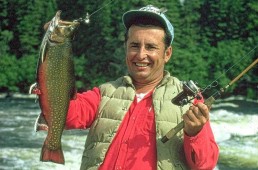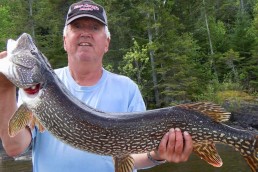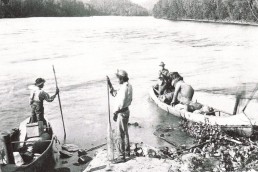Gapen Returns: Brookie Baptism at Pine Rapids
I was 6 years old when my father, Don Gapen, decided I should accompany him on a canoe trip down the world-famous Nipigon River. We began our trip at Virgin Falls, the very spot where Dad had created the world-famous Muddler fly two years earlier. It was an undertaking that would begin my love of rivers and the fishing opportunities they present.
Much of the trip is lost from memory, but one part of the fast-water trip shines vividly in my mind. It happened at Pine Rapids. Throughout the trip, I sat between my father’s knees in the middle of an 18-foot, double-pointed, canvas-covered canoe. Dad sat on a wooden apple crate, which added the height he needed to cast a fly shoreward where the wary brook trout lie. This forced me to troll a similar fly behind us as the canoe was maneuvered downstream through the violent, rapid water.
It was on this trip—and specifically in Pine Rapids—that I learned the technique of slipping a river. (An explanation of slipping to follow later in this article.)
Halfway through the run down Pine Rapids, Dad missed a rather large brook trout in a small eddy on the west bank. He caught other brookies during the run, the largest as I best can remember, about 5 1/2 pounds. As we beached at the rapids’ end, he asked if I’d like to take the run down Pine Rapids alone, with only the two native guides. A bit frightened but equally excited by the opportunity, I agreed to give it a go.
“You have learned to cast enough line to reach shoreline and the trout, son,” my father said. “Just cast that amount of line and you’ll be okay.” His words flowed with me as our two native guides lifted the canoe to shoulders and headed up the portage with the intent to reach the top of Pine Rapids.
To accommodate the little angler, the natives, one on either end of the canoe, once launched, would paddle upstream hard as the canoe moved downstream under the influence of the fast rapid water. Thus, the method of slipping a watercraft was performed. It’s the best method of boat control that can be used in fast-moving river water. It stayed with me ever since I observed this technique, and as many of my readers have noted, I continue to use slipping in my river fishing, no matter what style of watercraft.
From one of my earlier writings…
Today, the river angler can best handle his boat in running water, no matter what the watercraft, by slipping. Slipping is a technique which can be applied by placing your outboard motor in forward thrust, then idling back until your boat is sliding backwards downstream. This accomplishes three things. As the watercraft slips backwards with the motor going forward, you gain complete control of the craft. This technique also allows the boat driver freedom to cast an equal number of casts with whoever is on the boat with him. It also allows the angler to cast at an angle upstream and retrieve downstream, which is proper presentation of a lure in running water.
Back to my baptism at Pine Rapids…
At the spot Dad missed the large brook trout, I connected and fought to canoe a 6-pound-plus beautiful male brook trout. That radiant fish remains in my memory as vividly today, at the age of 83, as if it were yesterday.
As my native guides beached the canoe at the rapids’ lower end, Dad was waiting.
“Dad, look–look what I caught, the one you missed,” I blurted out while holding up my prize.
Father, as he always did, smiled widely and congratulated me, asking what fly I’d caught him on. “A Muddler, Dad, and my cast was only 25 feet,” I replied as family pride welled up in me.
Many lessons were learned on the first trip down the Nipigon, some lost in memory but many remembered. If years allow, as I again begin writing for MidWest Outdoors, these lessons learned years ago will come forth in my columns.
Until next time, this has been the Old Man, Dan Gapen, Sr., hoping you relax, savor, and enjoy our great outdoors. It’s yours to save for all to come after you.
Considered one of the world’s leading river anglers, Dan Gapen, Sr. will continue to recount his past and recent adventures, and offer up his knowledge to MidWest Outdoors readers. Welcome back, Head River Rat…
MWO
SHARE THIS POST
Did you enjoy this post?
You can be among the first to get the latest info on where to go, what to use and how to use it!
Dan Gapen
Considered one of the world’s leading river anglers, Dan Gapen, Sr. has shared his knowledge with MidWest Outdoors readers and viewers for more than 40 years. He is a member of all three Fishing Halls of Fame—International, National Freshwater, and Minnesota. He has an immense grasp of the world’s fisheries. He may be contacted at 877-623-2099.
@TheGapenCompany.


